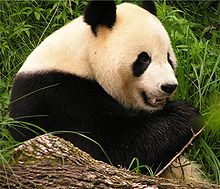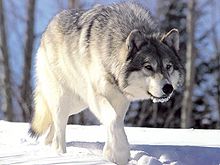Predators
| Predators | ||||||||||||
|---|---|---|---|---|---|---|---|---|---|---|---|---|

South China tiger with prey |
||||||||||||
| Systematics | ||||||||||||
|
||||||||||||
| Scientific name | ||||||||||||
| Carnivora | ||||||||||||
| Bowdich , 1821 | ||||||||||||
| Superfamilies | ||||||||||||
The predators (Carnivora) are an order of mammals (Mammalia), to which the canine species (Caniformia) and the feline species (Feliformia) belong.
As predators , who mainly feed on vertebrates , the carnivores are distributed almost worldwide with 16 recent families and around 270 species in 110 genera .
The scientific name "Carnivora" is made up of the Latin terms caro, carnis "meat" and vorare "devour". But not all of them are just carnivores ; for example, the bears (Ursidae) are opportunistic omnivores , and some species are also pure herbivores , including the giant panda .
features

General
The representatives of the carnivores are very diverse both in terms of their external attributes and their habitats . This diversity becomes visible in the comparison between the smallest predator on earth, the weasel , whose females weigh less than 50 g, and the largest predator on earth, the southern elephant seal , whose bulls are up to 6.5 meters long and more than 3.5 meters Tons can be heavy. In comparison, the sperm whale , which does not belong to the group of predators, is up to 20 meters in length and 50 tons in weight, the largest predatory animal on earth.
Jaw and teeth

The teeth of the terrestrial predator families based on the following tooth formula on incisors (incisors) 3/3, canines (canines) 1/1, premolars (Vorbackenzähne) 4/4 Molar (molars) 3/3. Depending on the species of predator, the characteristics are different, with the canines, the so-called fangs (not fangs, see below), are usually extremely elongated. Almost all species have six small incisors each in the upper and lower jaw. The few exceptions are the sloth bear , which has only two incisors in each half of the upper jaw so that it can suck up insects through the gap, and the sea otter , which only has four incisors in the lower jaw.
In addition, all land carnivores have a characteristic set of teeth: the so-called P4 / M1 crushing shears , which each consist of two sharp fangs and are ideally suited for cutting up meat. Two fangs in each half of the jaw form such a functional unit. The upper fang tooth is the last molar tooth in the upper jaw (premolar 4 = P4), the lower one is the first molar tooth (molar 1 = M1) in the lower jaw. In hyenas they are particularly strong and are even suitable for breaking large bones, in omnivores such as bears and small bears they are less pronounced. In contrast to the conspicuous fangs, the remaining molars of the predators are usually rather small. The number of molars is reduced in some groups, for example in cats .
The seal's teeth differ significantly from those of land-based predators. It specializes in holding slippery fish and consists of one or two pairs of lower incisors, often relatively inconspicuous canines, and 12 to 24 conical, homodontic (similar) molars. Extreme modifications are the tusks ( tusks ) of the walrus or the modified molars of the crab eaters .
Characteristic of predator skulls are expansive zygomatic arches , a large temporal pit as the source of the strong temporal muscle , which is important for biting , as well as the connection between the eye socket and the temporal window. The lower jaw is anchored in the upper jaw so that it can only be moved up and down; Sideways movements such as when chewing are not possible.
limbs
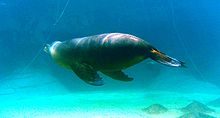
Predators have four or five toes on each foot. The thumb cannot be opposed to the other toes and in some species is receded or reduced. The carpal bones are usually fused, which strengthens the wrist. The collarbone is reduced or completely disappeared in seals as well as in the other groups. In other mammals, it is used to allow the limbs to move sideways. However, predators, which are primarily geared towards chasing prey, mainly move their legs back and forth. Some predators like cats and dogs walk on their toes while others like the bears are sole walkers . Some, such as cats and crawling cats, have retractable claws as a special feature. The seal's limbs are heavily modified and transformed into fins with webbed toes connected.
organs
Because of the mostly low level of specialization in food intake, like the teeth, the digestive tract is also quite primitive compared to many herbivores and thus offers greater adaptability. It consists of the stomach and a relatively short intestine.
Female predators have a two-horned uterus. They have mammary glands that are on the stomach. Male predators (with the exception of hyenas) have a penis bone (baculum), the testicles are on the outside.
The relatively large brain is very furrowed.
Distribution area and habitats
With around 270 species, the predators are one of the more species-rich orders of mammals. They occur on all continents, although in Antarctica they can only be found on the coasts. With the exception of ear seal colonies on the south coast, Australia was previously predator-free, but in historical times the Australian dingo and in modern times the red fox and domestic cat were introduced by humans.
All feline families , with the exception of the cats themselves, which are also found in North and South America, are naturally limited to the ancient world . Two families of the feline, the Malagasy carnivores and the pardle roller , have very small distribution areas and occur exclusively in Madagascar and in Central Africa. The remaining three, hyenas, mongooses and crawling cats, are common in Africa, Asia and in peripheral areas in Europe. Among the canine species , the dogs, bears and martens are distributed almost worldwide and are originally missing only in Australia and the Antarctic. However, the bears became extinct in Africa with the atlas bear in the Holocene . The skunks are common in Southeast Asia and America, the cat bears with one species are restricted to Asia and the small bears live exclusively in America. In three families, the water predators inhabit the coastal waters of all continents, as well as a few freshwater lakes.
Predator habitats are varied and there are few habitats that they do not populate. They can be found from the pack ice belt to tropical rainforests and from coastal seas to dry deserts.
Way of life
Social behavior
The range of social behavior is not only large among predators, but also varies significantly within the individual animal groups. Often the type of society is closely related to the type of hunting and diet of the respective species. Some species live in packs (wolves, lions) or colonies (sea lions), others as solitary animals (leopard, brown bear) or in family groups (jackals).
nutrition
Most predators are carnivores. They cover their meat needs by hunting or eating carrion . However, a large part of the Carnivora is omnivorous , i.e. omnivorous , which means that in addition to meat, they also eat other foods such as berries or grasses. Many smaller predators such as mongooses, but also some larger species such as the spoonbill , aardwolf and sloth bear, feed largely on invertebrates , mainly insects . Some species of predator, including the giant panda , the pardle roller or the wrapped bear , are primarily or almost exclusively herbivores. However, one finds numerous highly specialized predators within this order.
There are many ways in which predators hunt down their prey. Some species, such as wild dogs, chase their prey to the point of exhaustion, others sneak up close to their prey and surprise them with a quick attack, such as cats. Martens are able to track fast-climbing squirrels in trees, weasels chase rodents in their tunnels and seals hunt fish. Large seals such as elephant seals reach depths of over 1000 meters. Some predators are able to kill animals that are significantly larger than they are. For example, tigers can kill gaure (large cattle from Southeast Asia), and ermine can kill a rabbit that weighs many times its body weight. Some species primarily hunt in groups, while others hunt alone.
Reproduction
Most species of predator throw about once a year, smaller species also several times. In large species such as big cats and bears, two to three years usually pass between two litters . The gestation period varies between 50 and 115 days. The young are usually born small, blind and unable to survive on their own.
Delayed embryo development occurs in some martens and bears . This mechanism, known as dormancy , extends the gestation period and ensures that the young are born at the most favorable season possible.
Systematics
External system
Based on molecular genetic findings, the carnivores are now part of the large mammalian line of Laurasiatheria , which also includes insectivores, bats, odd ungulates, cetartiodactyla (whales and ungulates) and pangolins. Within the Laurasiatheria, the predators are now usually placed in a separate group, the Ferae , together with the pangolins and the extinct Hyaenodonta and Oxyaenodonta . According to this view, their sister group would be the odd ungulates. A possible cladogram of the Laurasiatheria looks like this:
| Laurasiatheria |
|
||||||||||||||||||||||||||||||
|
|
While the Ferae are considered relatively safe today, there are still regular discussions regarding the system within the Laurasiatheria. Within the Ferae, the predators and their extinct relatives ( Miacidae and Viverravidae ) are usually united to form the higher taxon Carnivoramorpha , while the immediate closer relatives of the carnivores are called Carnivoraformes (often excluding the Miacidae, which are to be understood as paraphyletic ) . Other predatory groups of the Ferae, such as the extinct Hyaenodonta and Oxyaenodonta , were originally part of the " Creodonta ", which were considered to be the sister group of the predators. Today the "Creodonta" are also classified as a non-self-contained group. Phylogenetic studies from 2018 imply that the Carnivoramorpha may also be paraphyletic, as they exclude the Viverravidae, but classify the Oxyaenodonta basally into the Carnivoraformes.
Internal system
Rough classification

The classic classification of carnivores provided two sub-orders, the land carnivores and the water carnivores ; the latter were the seals, the former all land-dwelling predators. As things stand today, this subdivision is obsolete, as seals evolved from canine-like predators and can therefore be assigned to them. This affiliation is based on both morphological and molecular genetic studies. According to this, the early predators did not first split up into land and water predators, but into dog-like (Canoidea) and cat-like (Feloidea). A distinction has been made between these two lineages for a long time, although in the past the seals were not counted among the canine species.
Today it is undisputed that the three seal families are a monophyletic taxon, i.e. all of them go back to a common ancestor. The monophyly of the traditionally differentiated land carnivore families was largely confirmed. This is especially true for dogs, bears, hyenas and cats. The other traditional families, the marten-like, small bears, crawling cats and mongooses, are still valid, but had to be partially restructured in order to do justice to the new taxonomic findings. The skunks form a family of their own with the stink badgers of Southeast Asia, the little panda is separated into its own family Ailuridae and the Malagasy predators form a monophyletic taxon. According to molecular genetic studies, the Pardelroller and the Linsangs also represent separate families.

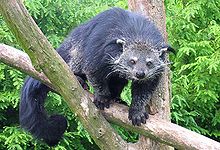
-
Canine (Caniformia)
- Dogs (Canidae) (with wolves, foxes and jackals)
- Bears (Ursidae)
- Walruses (Odobenidae)
- Ear seals (Otariidae)
- Dog seals (Phocidae)
- Little pandas (Ailuridae)
- Skunks or skunks (Mephitidae)
- Small bears (Procyonidae)
- Marten (Mustelidae)
-
Feline (Feliformia)
- African palm civet (Nandiniidae)
- Cats (Felidae)
- Linsangs (Prionodontidae)
- Crawling cats (Viverridae)
- Hyenas (Hyaenidae)
- Mongooses (Herpestidae)
- Malagasy carnivores (Eupleridae)
Systematics at the family level
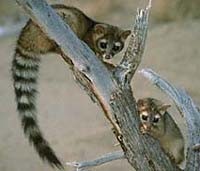
Molecular genetic analyzes have recently been able to shed some light on the more precise relationships between the predator families, even if individual questions are still unanswered. What is certain today is that within the canine species, the canids (dogs) are opposed to all other current groups that are summarized as Arctoidea . The Arctoidea itself is divided into the three main clades bears, seals and Musteloidea. The latter include the cat bears, skunks, small bears and martens. The system under the Musteloidea is not entirely certain, but the martens and the small bears seem to form a unit whose sister group is the skunks. These three groups would therefore be confronted by the cat bears as a separate group within the Musteloidea. According to current knowledge, only the little panda belongs to the cat bears. The giant panda, on the other hand, is now assigned to the large bears (Ursidae). The position of the extinct Amphicyonidae among the canine species remains unclear .
Within the feline group, the pardel rollers, which are currently only represented in Central Africa with only one species, surprisingly turned out to be a family of their own, facing all other surviving families from the cat branch. Furthermore, all Malagasy carnivores form a monophyletic group that is closely related to the mongoose. The sister group of these two groups are likely to be the hyenas. In addition to the pardle rollers, three main lines should be distinguished among the cats: (1) the cats and the linsangs, (2) the crawling cats (without pardle rollers and Malagasy predators) and (3) a group consisting of hyenas, mongooses and Malagasy predators composed. It is unclear whether the cats or the stealthy cats are closer to the hyena-mongoose branch.
| Internal systematics of the predators | |||||||||||||||||||||||||||||||||||||||||||||||||||||||||||||||||||||||||||||||||||||||
|---|---|---|---|---|---|---|---|---|---|---|---|---|---|---|---|---|---|---|---|---|---|---|---|---|---|---|---|---|---|---|---|---|---|---|---|---|---|---|---|---|---|---|---|---|---|---|---|---|---|---|---|---|---|---|---|---|---|---|---|---|---|---|---|---|---|---|---|---|---|---|---|---|---|---|---|---|---|---|---|---|---|---|---|---|---|---|---|
|
The exact position of the extinct Amphicyonidae , Barbourofelidae , Miacidae , Nimravidae and Viverravidae , as well as the hyena-like Stenoplesictidae and Percrocutidae is also unclear .
Tribal history
Division into cats and dogs
According to the conventional opinion, the predators had already split into the two great predator lineages, the feline (Feliformia) and the canine (Caniformia), in the early Paleocene . The oldest group of the former has been the extinct family Viverravidae , which has been recorded as early as the Paleocene. One of their representatives, for example, was the graceful tree-living genus Protictis . The Miacidae , which appear from around the late Paleocene, were usually considered to be the earliest group of canine species . (Originally, the miacids were even considered to be the forerunners of all predators.) Their paws were flexible, indicating climbing ability, and they had full set of 44 teeth. The scissors bite (crushing scissors) was already developed.
However, recent studies indicate that the miacids and viverravids are not the direct ancestors of the two predator lines, but can even be found completely outside of the Carnivora. The miacids don't even seem to be a monophyletic group. According to these findings, viverravids and miacids are combined with the predators to form a taxon, the Carnivoramorpha. According to these results, the two main lines of Carnivora only diverged about 43 million years ago.
Development of the feline
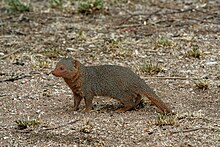
One of the oldest families from the cat branch are the Nimravidae , which are very reminiscent of cats (Felidae), but are viewed as a separate family. They first appeared in the late Eocene of North America and Eurasia. Another family, the Barbourofelidae , were originally considered a subfamily of the Nimravidae, but are now considered a family of their own. The Barbourofelidae did not become extinct until the late Miocene with the North American genus Barbourofelis .
The first representative of the cats themselves was Proailurus from the Oligocene and Miocene of Europe. It was about the size of an ocelot . The cats first immigrated to North America in the Miocene and quickly displaced the Nimravids who lived there. In the Pliocene, they also immigrated to South America. The other feline families, apart from a North American Pliocene genus of hyena, remained confined to the Old World and never reached the American continent.
Canine evolution
The second lineage of predators is the canine. Their eponymous family, the dogs (Canidae), is primarily represented in North America in terms of evolution and was originally limited to this continent. The genus Hesperocyon from the middle Eocene was the first known member of this family. The dogs did not reach Europe in the Miocene, Africa, Asia and South America before the Pliocene .
The second family, the bears, also appeared first in North America, reaching Eurasia and Africa in the Miocene. In contrast to today's forms, the first bear was still quite small. Parictis from the late Eocene had a skull only 7 cm long. The other canine families, to which the extinct Amphicyonidae family belonged in addition to the ones that still exist today , can be traced back to the early Oligocene at the latest in North America as well as in the Old World. Canine species, like cats, did not reach South America until the Pliocene, after the creation of the Central American land bridge . Only the small bears have been recorded on this continent since the late Miocene.
The seals, which belong to the Arctoidea group within the canine species, are only known from the Oligocene . Enaliarctos, for example, already had fins and lived in the late Oligocene of California. The molars of this early genus were hardly modified fangs, as they are typical for land carnivores. Representatives that can be assigned to the three seal families are known from the Miocene. Ear seals and walruses were common on the coasts of the North Pacific, while the dog seals lived in the North Atlantic.
Extinct carnivores of other mammalian groups
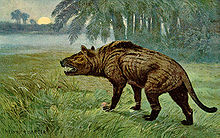
Before the Carnivora evolved into the peak robbers, this niche was filled by two other mammalian orders that died out long ago. The first were the mesonychia , carnivorous ungulates that were common in the Paleocene and Eocene. They produced the first large carnivores among the higher mammals. Other groups of predatory mammals were the Hyaenodonta and the Oxyaenodonta , which were originally grouped together as Creodonts . In the early Paleogene the actual predators were still relatively small, but the Creodonts were represented with a considerable abundance of large carnivores. Like the Carnivora, the Creodonts had developed a scissor bite. The crushing claws of predators and Creodonts, however, each consisted of different molars, evidence that both groups developed independently of one another, i.e. converged .
On the continents of Australia and South America, where no modern predators lived for a long time, the role of larger carnivores was originally played by various species of marsupial . Carnivorous marsupials of the order Sparassodonta lived in South America until the Pliocene , to which the saber-toothed cat genus Thylacosmilus belonged. With the formation of the Central American land bridge and the great American fauna exchange at the end of the Pliocene, Carnivora immigrated from North America and displaced their South American competitors . Under the special conditions of Australia, some medium-sized carnivores could develop among the marsupial , such as the pouch martens and the marsupial devil , which belong to the predatory baggers . The pouch wolf , which disappeared in the 20th century, belongs to another predator-like family . Carnivores outside of the predator-like were z. B. the marsupial lions , which died out in the Pleistocene , or carnivorous kangaroo species of the genus Ekaltadeta , which died out in the Upper Miocene .
Meaning, history, culture
Large predators have been humans' food competitors since ancient times. Many predators were persecuted as enemies of the farm animals of humans and lost a large part of their habitat due to the spread and competition of humans. The hunting of wild animals resented them man and decimated them for this reason. Large carnivores were persecuted in Yellowstone National Park even after the National Park was established; the wolf was exterminated and only reintroduced in 1995. Many predators were or are hunted for their fur to make clothing and as hunting trophies . Today, a number of species are threatened with extinction and the populations of large predators in particular have often melted down to small relic populations.
In some places, however, a rethinking can be seen today. In Europe and North America in particular, some large carnivores seem to be able to make up some of the lost ground. Wolves have been reintroduced into Yellowstone National Park and bears, wolves and lynxes are increasingly establishing themselves in Central Europe. Some adaptable species, such as the red fox or martens , especially the stone marten , are increasingly penetrating human settlements and are able to make a living even in large modern cities.
The large species such as lions, tigers, bears and wolves in particular have acquired mythical importance and have found their way into numerous legends.
Some species (especially house dogs and cats ) are also kept as pets by humans . Different martens are bred for their fur or, in the case of the ferret, to hunt rabbits and hares.
Several species of predator, such as the red fox, are carriers of dangerous diseases such as rabies .
literature
- DE Wilson, DM Reeder: Mammal Species of the World. Johns Hopkins University Press, 2005, ISBN 0-8018-8221-4 .
- David Macdonald: The Great Encyclopedia of Mammals. Könemann, Königswinter 2004, ISBN 3-8331-1006-6 .
- Thomas S. Kemp: The Origin & Evolution of Mammals. Oxford University Press, Oxford 2005, ISBN 0-19-850761-5 .
- Don E. Wilson, Russell A. Mittermeier (Eds.): Handbook of the Mammals of the World. Volume 1: Carnivores. Lynx Edicions, 2009, ISBN 978-84-96553-49-1 .
- John J. Flynn et al: Molecular Phylogenie of the Carnivora (Mammalia): Assessing the Impact of Increased Sampling on Resolving Enigmatic Relationships. Systematic Biology 54 (2), 2005; Pp. 317-337. doi : 10.1080 / 10635150590923326 full text
- Gina D. Wesley-Hunt, John J. Flynn: Phylogeny of the Carnivora: Basal Relationships among the Carnivoramorphans, and assessment of the position of 'Miacoidea' relative to Carnivora. Journal of Systematic Palaeontology 3 (1), 2005; Pp. 1-28. doi : 10.1017 / S1477201904001518
Web links
- Predators: The dangerous helpers , article by Peter Laufmann in Spiegel Online , February 5, 2012 (originally published in natur + kosmos , issue 2/2012)
Individual evidence
- ^ T. Edward Bowdich: An Analysis of the Natural Classifications of Mammalia, for the Use of Students and Travelers. Paris 1821, p. 33 ff. ( Online at GoogleBooks , freely downloadable)
- ^ Harald Schliemann: Carnivora, predators. In: Wilfried Westheide , Reinhard Rieger : Special Zoology. Part 2: vertebrates or skulls. Spektrum Akademischer Verlag , 2004, ISBN 3-8274-0900-4 , p. 586.
- ↑ elephant seals on world-of-animals.de.
- ↑ after Westheide / Rieger (2004), p. 503.
- ^ Shawn P. Zack, A skeleton of a Uintan machaeroidine 'creodont' and the phylogeny of carnivorous eutherian mammals. Journal of Systematic Palaeontology, 2018 doi: 10.1080 / 14772019.2018.1466374
- ↑ Katrin Nyakatura, Olaf RP Bininda-Emonds: Updating the evolutionary history of Carnivora (Mammalia): a new species-level supertree complete with divergence time estimates. BMC Biology 10, 2012. doi: 10.1186 / 1741-7007-10-12
